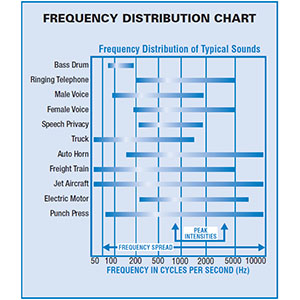
To define your specific problem, you need a basic understanding of how to quantify both your unwanted noise and the sound level that will be acceptable. The difference between those two values is the degree of sound control you need to achieve with your door opening. That understanding requires a brief overview of the science of sound and its measurement.
We begin with a few important definitions:
- Sound is vibrations in air moving in waves. The rate of sound pulsations measured in cycles per second is called frequency—also known as hertz (Hz). The range of human hearing is considered to be 20 to 20,000 Hz.
- Sound pressure levels are measured in decibels—or dB. The scale of measurement used to simulate sound across the audible frequency range is denoted as dBA. Figure 1 illustrates the impact of dramatic changes in dB levels. It is also important to note that the human ear perceives changes in loudness caused by even small changes in those levels. Each 10 dB increase doubles the sound reception—and the annoyance or discomfort that goes with it.
Comparison of sound pressure levels and loudness sensations | ||
Sound pressure level (dBA) | Source | Sensation |
130 | Jet aircraft at 100' Bass drum at 3' Auto horn at 3' | Physical pain |
120
110
| Thunder, artillery, nearby riverter evevated train, discotheque | Deafening |
100
90 | Loud street noise, noisy factory Track unmuffled,police whistle | Very loud |
80
70 | Cocktail party, noisy office, average street noise Average radio, average factory | Loud |
60
50
| Noisy home, inside general office Conversation, quiet radio | Moderate |
40 30
| Quiet home, private office Empty auditorium, quiet conversation | Faint |
20 | Rustle of leaves | Very faint |
10 | Whisper, soundproof room | Very faint |
0 | Threshold of audibility |
|




